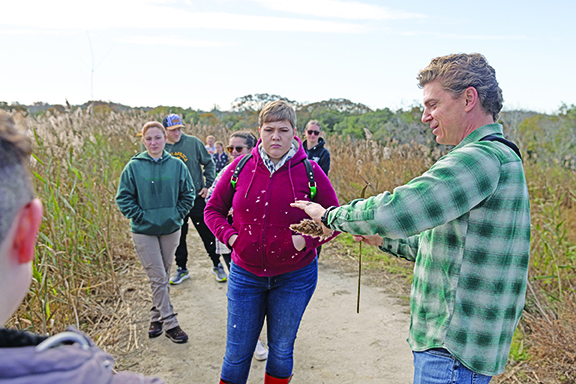Stockton University students get a lesson in local ecosystems on Cape May Canal
CAPE MAY — During fall migration, warblers, raptors and monarch butterflies traveling down the East Coast funnel through the Cape May peninsula.
Last week, Jason Kelsey and students in his Coastal Ecosystems class followed a sliver of their migratory route to learn more about habitats and differences in natural and developed coastlines.
With Cape May on National Geographic’s top 10 list of birding destinations in the world, students packed binoculars for the field trip.
The class, part of Stockton University’s Coastal Zone Management master’s degree program, met at Higbee Beach Wildlife Management Area to explore the natural bayshore and then took a short drive downtown to look at how beach engineering can reshape the coast.
Kelsey first took students to the Cape May Canal, home to the Cape May-Lewes Ferry, to climb up a mound of dry mud concealed by tall phragmites reeds.
The canal is dredged to keep the channel deep for safe passage, and the mud is deposited on the Higbee Beach side of the canal. At the top, the sun-scorched mud cracked apart into fragments. Coyote prints revealed that the students weren’t the only ones to explore the otherworldly landscape hidden by the dense vegetation that surrounds the base.
Casey Manera, an environmental studies graduate from Millville, has been visiting Higbee Beach since high school and “fell completely in love with all things wetlands” after taking Kelsey’s Wetlands Ecology class a couple of years ago. Now she’s considering returning to Stockton for a master’s degree in Coastal Zone Management.
The field trip led Manera to new perspectives on a familiar place.
“I always knew the dredge spoil hill existed but never viewed it as a valuable part of the land. Learning that the mud can house dormant seeds was super interesting, and this huge mudflat also serves as a time capsule,” she said. “Kelsey explained that footprints can be preserved in layers of mud, which throughout millions of years become fossils.”
Manera spotted one of the few plants that emerged from the mud cracks — a pickleweed. The edible salty succulent, sometimes served on salads, was slowly turning red, which is a sign that the plant can’t hold anymore salt.
“I have such a deep connection to the marshes and barrier islands that pursuing a career to protect and manage these lands only made sense,” she said.
Her career sights are set on working with coastal nesting birds, and she hopes to create a project monitoring gull species that utilize the marshes to study how climate change might be affecting their productivity.
“Conducting fieldwork is what gets me out of bed in the morning. I’m very fortunate to have had a class that gave me tools to excel in the field as well as problem-solve to discover species I would have otherwise overlooked,” she said.
On the bay, a resident of the deep sea washed ashore. A slender and silvery Atlantic cutlassfish wriggled in the whitewater as the waves pushed it onto the sand briefly, offering the class a rare look at the eel-like fish, which flashed its fang-like teeth.
A hermit crab curled into a fragment of whelk shell, and yellow-rumped warblers, a late migrant, foraged through beach plum shrubs and the white fluffy seeds that were once the mustard yellow blooms of goldenrod.
Students collected quartz pebbles smoothed by the sea, known locally as Cape May diamonds.
A very different seascape revealed itself just a few miles away at the downtown beaches near the Cape May Convention Hall. The scallop-shaped shoreline, drawn by the ocean depositing fans of sand between the series of jetties, tried to mimic the gingerbread trim decorating the Victorian homes across Beach Avenue.
By SUSAN ALLEN/Special to the Sentinel



